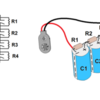Capacitors are fascinating devices. Since I have been building LED circuits for my O-gauge trains, I became curious about capacitors and their usage in electronics. Take a look at this website
http://www.instructables.com/i...itors-A-Practical-G/
Be sure to view the video as you go through the article.
I have used capacitors in LED lighting circuits to prevent feedback noise from affecting the DCS signals to my PS 2 and PS 3 locomotives. Capacitors like batteries are electrical energy storage devices, but unlike batteries they charge in seconds using track voltage and can last longer than we will.










